I’ve always loved watching backyard birds. Seeing them fly from tree to tree, their songs fill the air. It’s a joy to share how you can make your yard a home for different birds.
This guide will show you the world of bird houses. You’ll learn how to draw many birds to your yard. Enjoy birdwatching from home and see nature’s beauty up close.
Key Takeaways
- Learn how to create a backyard haven that attracts a variety of bird species
- Discover the joy of birdwatching from the comfort of your own home
- Explore eco-friendly and handcrafted bird house options to suit your outdoor space
- Understand the importance of proper placement and maintenance for a thriving avian population
- Diversify your backyard’s winged visitors by tailoring your bird house selection
Introducing the Delightful World of Bird Houses
Bird houses, also known as nesting boxes, are special places for birds. They give our feathered friends a safe and cozy home. By putting these houses in your backyard, you can attract many different backyard birds. These birds will make your yard lively and fun.
Why Every Backyard Needs an Avian Abode
Bird houses are important for birds. They give them a safe place to nest and raise their young. This helps keep the bird population healthy. These houses also help with feeding and breeding, which is good for the birds.
The Joy of Birdwatching from Your Home
Bird houses make birdwatching easy from your home. You can see many different birds up close. Watch the small songbirds play and the big birds soar in the sky. Enjoy the beauty and peace that birds bring to your yard.
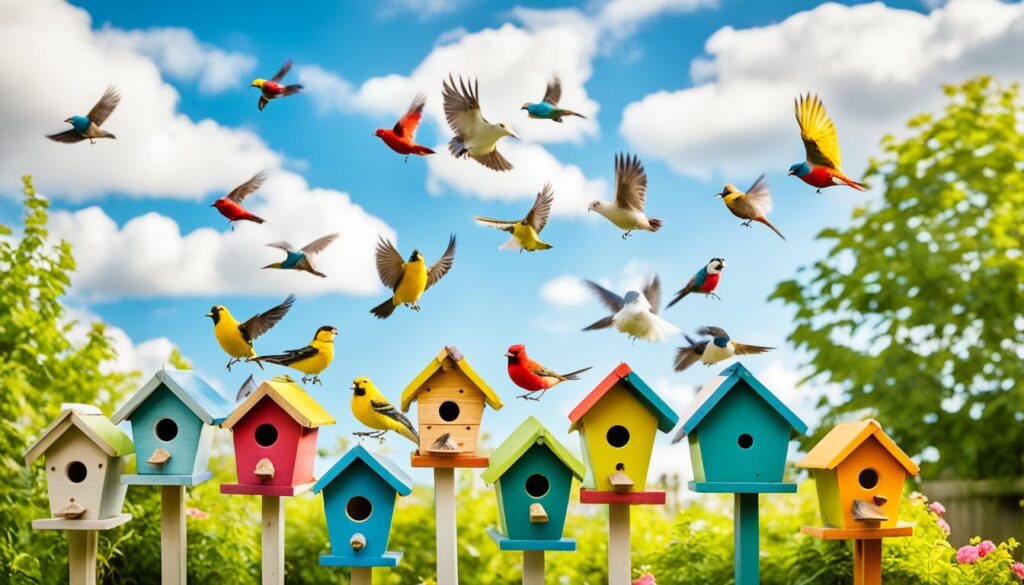
Selecting the Perfect Bird House
Choosing the right bird house is key to making a home for our feathered friends. As someone who cares about birds, I’ve found that the house’s size, design, and materials matter a lot. These factors affect how many birds will live there and their happiness.
Considerations for Size and Design
The size of a bird house must match the bird species you want to attract. Wooden birdhouses and nesting boxes vary in size. It’s important to know what your local birds need. Smaller birds like bluebirds and chickadees like cozy spaces. But larger birds, such as owls and woodpeckers, need bigger eco-friendly shelters.
The design of the bird house is also very important. Good designs have the right size entry holes to keep out predators. They also have good airflow and a way to clean and check on the birds easily.
Materials Matter: Eco-Friendly Options
Choosing materials for our bird houses is a big deal for the environment. Using sustainable, eco-friendly materials like cedar or pine wood helps birds and is good for our planet. These woods are safe for birds and fit our goal of taking care of our yards.
| Material | Advantages | Disadvantages |
|---|---|---|
| Cedar | Naturally weather-resistant, insect-repellent | Can be more expensive than other options |
| Pine | Affordable, easy to work with | Less durable than cedar |
| Recycled Plastic | Durable, low-maintenance | May not provide the same natural appeal |
Thinking about the size, design, and materials of our bird houses helps us make safe, green homes for birds. This supports the many bird species in our yards.

Bird Houses: Attract Feathered Friends to Your Yard
Welcoming backyard birds can be a rewarding experience. By offering safe nesting options, you can make your yard a vibrant place. I’ll share tips to attract a variety of backyard birds to your space.
Offering natural bird feeders and bird houses is a great way to attract birds. These provide shelter, nesting sites, and food. By choosing the right designs and materials, you can meet the needs of different birds and create a thriving ecosystem.
- Explore a diverse selection of bird house designs, from classic wooden structures to innovative modern styles, to accommodate the preferences of various bird species.
- Consider eco-friendly materials, such as reclaimed wood or natural fibers, to ensure your bird houses are both visually appealing and environmentally responsible.
- Strategically place your bird houses in areas that offer shelter, protection, and easy access to food and water sources, ensuring they become a haven for your feathered friends.
“Watching the birds in my backyard has become one of my favorite pastimes. It’s truly magical to witness their daily activities and the joy they bring to my outdoor space.”
Creating a bird-friendly backyard lets you start a birdwatching journey. Enjoy the beauty and wonder of these feathered friends. Let your outdoor space become a hub for nature’s enchanting creatures.
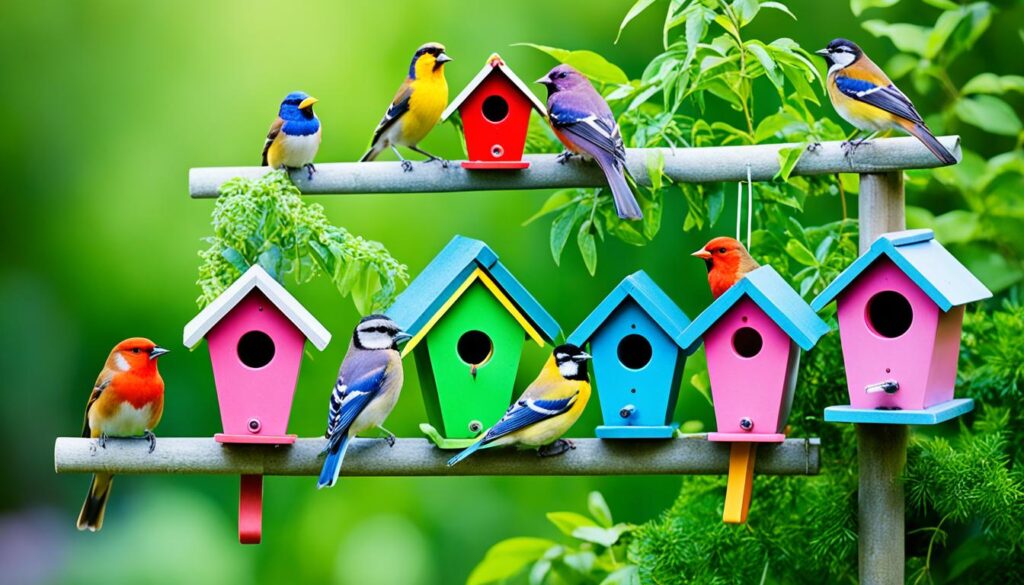
Placement Strategies for Maximum Occupancy
Attracting backyard birds means placing their homes just right. By choosing the best spots for your bird houses, you can make sure they’re filled with different birds. Let’s look at how to make your backyard a great place for birds.
Put your bird houses 5 to 15 feet off the ground. This height is safe and easy for birds to reach. Houses too low are at risk from predators. Houses too high are hard for birds to get into.
- Put your bird houses where they’re safe but you can still see them from your favorite spots outside. This way, you can watch the birds without bothering them.
- Don’t put bird houses near feeders or baths. This can cause fights over these important resources. Keep them in different spots to help birds live together peacefully.
- Think about the plants around your bird houses. Make sure they’re near places like dense shrubs or trees. This makes it easy for birds to find their nests.
Using these tips, you can make your backyard a great place for birds. You and your feathered friends will enjoy it a lot.
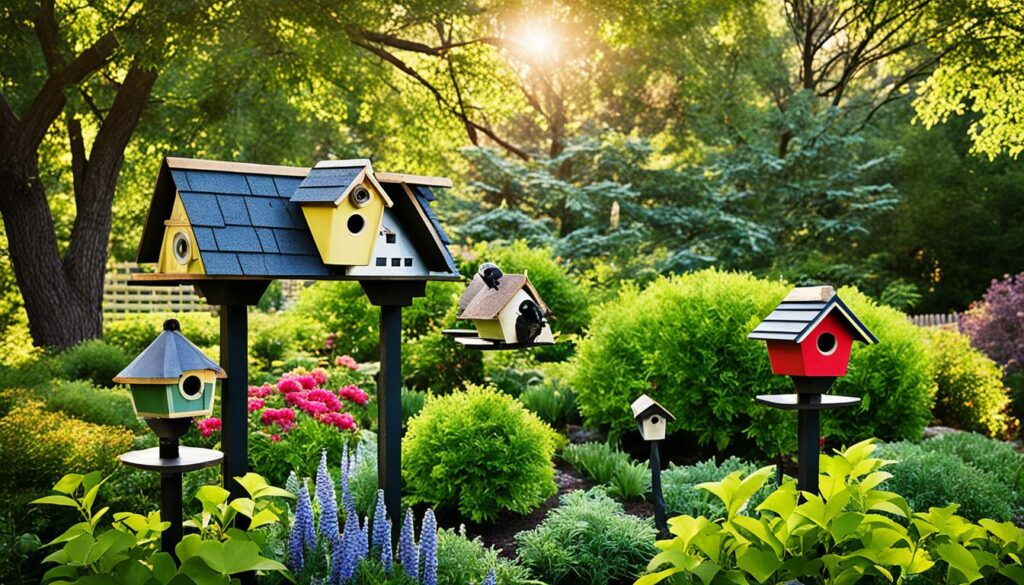
“The more you attract birds to your backyard, the more you’ll be able to observe and appreciate their fascinating behaviors up close.”
Handcrafting Your Own Wooden Birdhouses
For bird lovers, making your own wooden birdhouses is a special joy. It lets you meet the needs of local birds, turning your yard into a bird paradise.
DIY Projects for Avid Bird Enthusiasts
Starting a DIY project can be very fulfilling. You can make birdhouses that are cozy and add beauty to your yard. Whether you’re experienced or new to woodworking, there are many DIY projects to try. You can go from simple to complex designs.
You’ll need basic tools like wood, saws, and drills for these projects. Also, you might use paint or stain for finishing. It’s important to learn what different birds need in their homes. This way, you can make birdhouses that fit their needs perfectly.
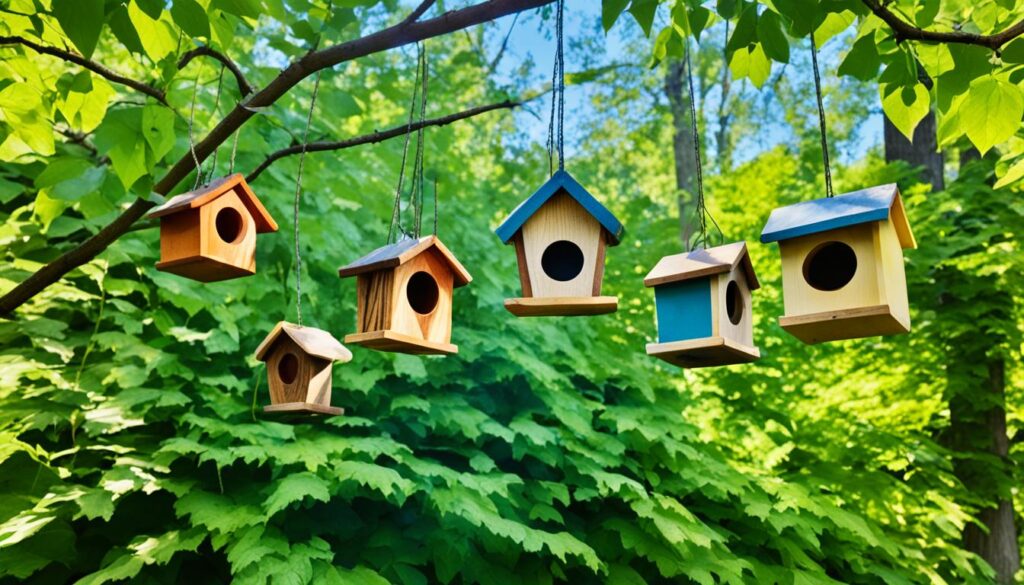
When you start making wooden birdhouses, you’ll love seeing birds move in. Building these homes is a rewarding task. It deepens your bond with nature, right in your own yard.
Nesting Boxes for Specific Bird Species
Creating a backyard haven for different birds is rewarding. You can do this by offering nesting boxes that meet the needs of local birds. Each bird has its own nesting preferences. By knowing these, you can make your backyard a home for many backyard birds.
Accommodating Cavity-Nesting Birds
Cavity-nesting birds like bluebirds, chickadees, and wrens like enclosed nests. Nesting boxes with the right size can be perfect for them. Make sure to consider the size, shape, and entry hole when picking the right box for your birds.
Nurturing Roosting Habits
Some birds use nesting boxes for roosting, especially in the cold months. Offering these backyard birds a safe place to roost helps them stay warm and save energy.
| Bird Species | Nesting Box Specifications | Ideal Placement |
|---|---|---|
| Bluebirds | 5-6 inch diameter, 6-8 inch depth, 1.5 inch entry hole | Open areas, 4-6 feet off the ground |
| Chickadees | 4-5 inch diameter, 8-10 inch depth, 1.1 inch entry hole | Wooded areas, 5-15 feet off the ground |
| Wrens | 4-5 inch diameter, 6-8 inch depth, 1.1 inch entry hole | Near shrubs or bushes, 5-10 feet off the ground |
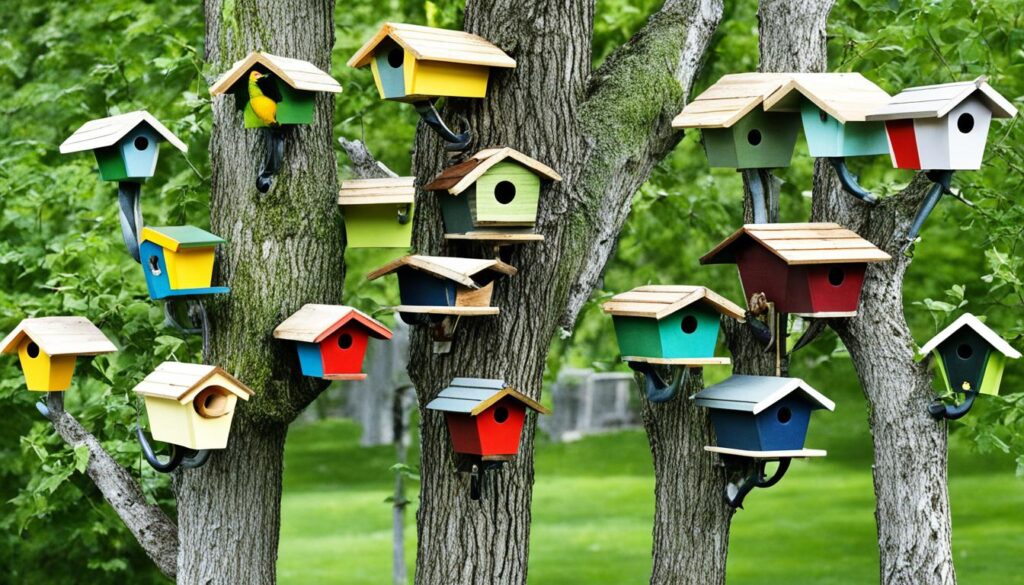
With the right nesting boxes, your backyard can be a home for many feathered friends. Enjoy watching your backyard birds in their custom homes.
Maintaining and Cleaning Avian Habitats
Keeping your avian habitats in top shape is key for your backyard birds‘ health. Regular upkeep and cleaning of bird houses make sure they are safe and comfy for your birds. It also stops pests and diseases from spreading.
To keep your avian habitats in good shape, just follow these easy steps:
- Clean the bird houses once a year, best in the fall after the nesting season ends.
- Use a soft-bristled brush and mild soap and water to clean the inside and outside of the bird house.
- Rinse the house well to get rid of soap, and let it dry before putting it back in your backyard.
- Swap out any worn or broken parts of the bird house to keep it strong and weatherproof.
- Add a new layer of nesting material, like dried grass or shredded bark, to help birds come back.
It’s also key to watch your avian habitats for pests or diseases. Fix any problems fast to keep your backyard birds healthy and happy. By doing this, you make a safe and inviting place for your birds to live.
“Maintaining and cleaning avian habitats is a vital part of attracting and caring for the birds in your backyard. It’s a small time investment that brings big rewards in the joy of watching your feathered neighbors thrive.”
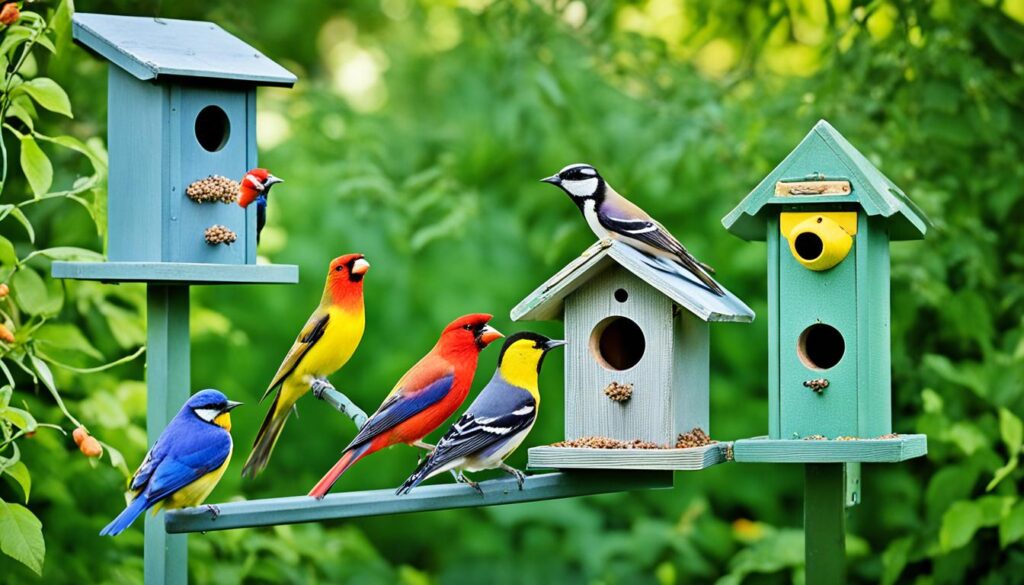
A well-kept avian habitat is good for the birds and makes your backyard more beautiful and peaceful. Enjoy making a place that’s great for your backyard birds to live.
By mastering the art of maintaining and cleaning your avian, you’ll get to enjoy the lovely sights and sounds of a diverse, healthy bird population in your backyard.
Attracting a Variety of Feathered Friends
Turning your backyard into a haven for backyard birds and feathered friends is rewarding. By making a multi-layered habitat, you can welcome many bird species. This makes your outdoor space lively and interesting.
Diversifying Your Backyard’s Winged Visitors
To draw in many backyard birds, add these things to your yard:
- Native plants and shrubs that offer food, shelter, and places to nest
- A mix of birdfeeders with different seeds, suet, and fruits
- A birdbath or water source for your feathered friends
- Birdhouses and nesting boxes for specific bird types
Meeting the needs of various birds turns your backyard into a haven for them. It becomes a place full of backyard birds. This brings joy and wonder to your life.
| Bird Species | Preferred Habitat Features | Recommended Birdwatching Accessories |
|---|---|---|
| Hummingbirds | Nectar-rich flowers, hanging feeders | Hummingbird feeder, binoculars |
| Woodpeckers | Suet feeders, dead or decaying trees | Suet feeder, field guide |
| Bluebirds | Open spaces, nestboxes, perches | Bluebird house, camera |
With the right bird-friendly features and birdwatching accessories, your backyard becomes a lively spot. Here, you can watch and enjoy the feathered friends that visit.

“The love of gardening is a seed that once sown never dies, but grows to the enduring happiness of the soul.” – Gertrude Jekyll
Bird Houses as Decorative Accents
Adding bird houses to your outdoor space can make it look better. These bird homes are not just for birds; they also make great decorations. They fit well with nature and add beauty to your backyard.
Enhancing Your Outdoor Living Space
Choose from handcrafted wooden or modern birdhouses to improve your outdoor area. These birdhouses can make your patio, garden, or backyard look better. Place them among plants and flowers to create a welcoming space for birds and people.
The designs and colors of these birdhouses bring fun and personality to your yard. You can match them with your backyard’s colors or choose bright ones to stand out. This makes your outdoor space more interesting for birds and visitors.
FAQ
What are the benefits of having bird houses in my backyard?
Bird houses in your backyard create a safe spot for local birds. This attracts many different birds, making birdwatching fun. It also helps the local bird population and makes your backyard more diverse.
How do I choose the right size and design for my bird house?
Choosing the right bird house size and design is key. Think about the bird species you want to attract and their needs. I’ll help you pick the perfect bird house for your backyard.
Where should I place my bird house for maximum occupancy?
Where you put your bird house is important for its success. I’ll give you tips on the best spots and heights for your bird houses. This ensures they’re easy to get to and offer great living conditions.
Can I build my own wooden birdhouses?
Yes, you can! Making your own wooden birdhouses is a fun DIY project. I’ll guide you in designing and building bird homes that meet the needs of local birds.
How do I maintain and clean my bird houses?
Keeping your bird houses clean is crucial for the birds’ health. I’ll show you how to clean and protect your bird houses from pests and diseases.
How can I attract a variety of bird species to my backyard?
To attract many bird species, make your backyard welcoming and diverse. I’ll give you tips on how to draw in different birds and recommend birdwatching accessories to enjoy them more.
Can bird houses be used as decorative accents in my outdoor living space?
Yes, bird houses can be decorative and add beauty to your outdoor space. I’ll show you how to blend them into your backyard design, making it both beautiful and bird-friendly.

Leave a Reply